- Bernard Preston homepage
- Beekeeping
- Honey Bee Traps
Honey Bee Traps
Honey bee traps are so easy to make. Increase your apiary during a flow.
Growing the apiary the easy way is done by placing an old-hive up on a suitable roof or tree stump during the swarming season. Provided the trap has been prepared in the correct way, you will catch a colony without fail.
I have already caught two swarms this year.
This natural beekeeping method is easier than splitting strong colonies, albeit that has its merits too. Our bee, apis mellifera is an inveterate swarmer. As soon as your hive starts to fill with honey, they will breed new queens; and whoops, half your workers have vanished over the horizon with much of the nectar they have stored.
We will have more discussion later on splitting-hives.
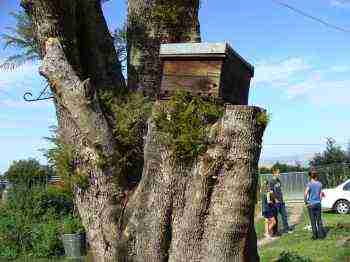
I say up high, perhaps a metre or two above the ground; that is the conventional wisdom of bee-lore. However, nothing beats a pile of old hives and that does not need to be raised up on the roof. Just make sure that your aging, empty boxes have frames in, preferably with some strips of wax; otherwise they will build comb in any and all directions.
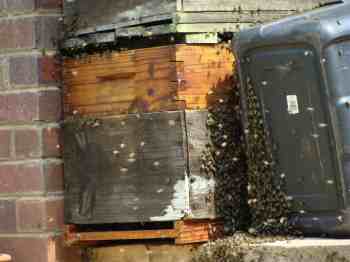
This page was last updated by Bernard Preston on 17th June, 2023.
How high should you place your honey bee traps? It is a bit of a compromise. In theory it should be about 3 to 5 metres above the ground; but then it is difficult getting a heavy-box down from a roof or up in a tree.
I find 2 to 3 metres above ground is fine. You might need a ladder; and then it gets more tricky. Dropping a hive full of bees would not be fun.
Where should you place the trap? Not on your own roof. It should be at least two kilometres away from your apiary, preferably more; and in an area where there is plentiful pollen and nectar. What you want is full-hives from the wild that are preparing to produce swarming bees; because the capacity of their hole in a tree or the ground is limited.
If you move the hive a short-distance, the bees will simply return the next day to where your box was; and you will lose most of the workforce.
How long should you wait before bringing the hive with a new-colony to your home apiary? Beginners often make a mistake here. You see, initially the scouts come and check the trap out. They start cleaning it, getting all in readiness for the day when the Her Majesty will bring her swarming bees.
Beginners tend to think the swarm has already moved in; and take the box to their apiary, only to have a big disappointment the next day. Unless you get it back up quickly, you will lose the colony that was just preparing to make a home in your bee trap.
How do you attract swarming bees? Only use a hive that has been previously occupied by the little beasties. If you have a new box, then place it on top of an existing colony for a week for the smell of the insects to permeate the frames thoroughly.
Ideally if you have ten frames in the bee trap, then you need the following.
- 2 or more frames that have been worked by bees. Old combs are perfect but new ones that have spent a week on an existing beehive are fine. They must have started drawing out the foundation but not so long that they have begun to store honey; or eggs have been laid. Don't leave it there for more than a month.
- Four outer-frames, two on each side that have full foundation are needed. If they are drawn out, as above so much the better.
-
Then you'll need four inner-frames in the centre with only a strip of foundation wax
perhaps two centimetres wide; also preferably drawn out as above.
We have found that swarming bees will choose a trap with this space created by using strips in the centre over one with full foundation throughout the hive. It is a place where the new and often quite small colony can cluster.
Ideally within a week of moving in, you could replace these strip frames with full foundation. Why? Because the workers will build drone cells, and you do not want that. You need a hive full of workers, not lazy males.
- A chunk of cotton wool doused in lemon-balm helps.
- I have also started rolling hot dirty wax that is full of propolis over the new foundation and even the sides of the hive; especially around the entrance.
Newsletter
Our newsletter is entitled "create a cyan zone" at your home, preserving both yourself and Mother Earth for future generations; and the family too, of course. We promise not to spam you with daily emails promoting various products. You may get an occasional nudge to buy one of my books.
Here are the back issues.
- Lifestyle and ideal body weight
- What are ultra-processed foods?
- Investing in long-term health
- Diseases from plastic exposure
- Intensive lifestyle management for obesity has limited value
- A world largely devoid of Parkinson's Disease
- The impact of friendly bacteria in the tum on the prevention of cancer
- There's a hole in the bucket
- Everyone is talking about weight loss drugs
- Pull the sweet tooth
- If you suffer from heartburn plant a susu
- Refined maize meal and stunting
- Should agriculture and industry get priority for water and electricity?
- Nature is calling
- Mill your own flour
- Bake your own sourdough bread
- Microplastics from our water
- Alternative types of water storage
- Wear your clothes out
- Comfort foods
- Create a bee-friendly environment
- Go to bed slightly hungry
- Keep bees
- Blue zone folk are religious
- Reduce plastic waste
- Family is important
- What can go in compost?
- Grow broad beans for longevity
- Harvest and store sunshine
- Blue zone exercise
- Harvest and store your rainwater
- Create a cyan zone at your home
In short prepare a bee trap with a couple of old-combs and eight foundation frames; place it on an existing hive for a week, or less if you are in a strong honey flow; until the workers have started drawing out the wax. Then remove the box and place it on your tree stump, tank or roof; it will not be long before the wild swarm arrives if there is plenty of nectar and pollen available.
I have
caught hundreds of colonies in this way; actually probably thousands over sixty years of
backyard beekeeping. It works, but only if it's during a honey
flow. It is a complete waste of time during a dearth of nectar
and pollen; it is not the swarming season.
Don't delay
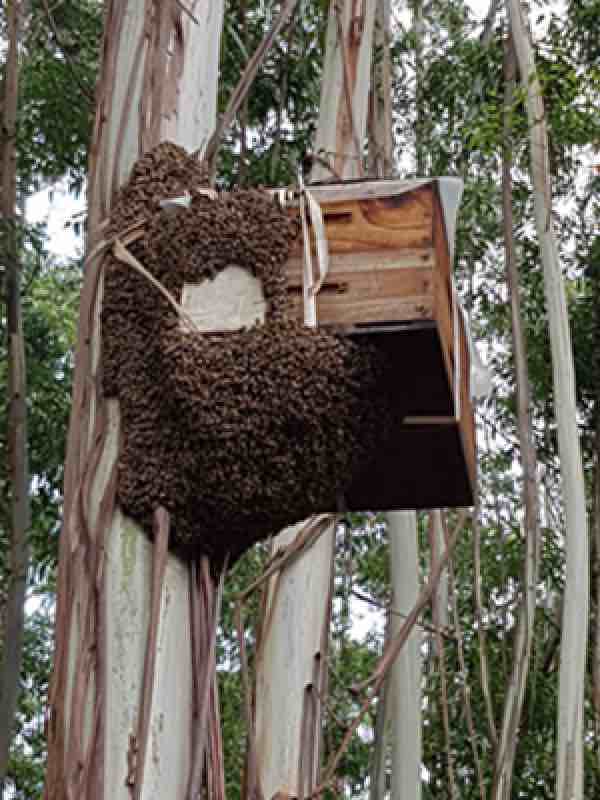
Do not delay in moving your honey bee traps to their permanent location. That means within three-weeks of them moving in; that is when the new brood will start hatching.
These bees in this honey bee trap have far exceeded their living quarters and, in that clump under the hive, they've actually started building comb in which the queen has begun to lay eggs.
As a rule of thumb move your catch boxes within three-weeks of the new colony taking up residence; they are much less fierce before the young brood starts hatching.
Requeening
All serious beekeepers get involved in requeening their honey bee traps; it is the old lady who is driven out of the hive and arrives in your catch-box.
Requeening reduces the strong swarming instinct of some species like our Scutellata; and obviously if she lays an abundance of eggs, the more workers there will be. There will be more honey for you.
I did it for several years but there were several difficulties.
- It broke my heart to squash the existing aging queen.
- With Italians it may be relatively simply, but with our aggressive colonies, she is difficult to find and there is the likelihood of getting the whole neighbourhood stung.
I eventually decided it makes more sense to split a boiling colony that is about to swarm, introducing a queen-cell; or placing a frame of very young brood and eggs.
In the latter case, you lose about six-weeks, though, according to this timeline:
- Day 1: The queen emerges from her cell.
- Day 5 or 6: She sets off on her mating flight, and you hope a drongo doesn't get her.
- Day 19: Eggs should be present.
- Day 23: Larvae should be present.
And then unite the two colonies and you will have a very strong colony with a young queen; bee lore has it that the virgin will destroy the old monarch. I suspect that may not always be the case.
Pollen for prostates
Here are a few thoughts on the pollen in honey. Men should assume they will get problems with their prostate glands because it's very common; and extremely unpleasant.
You can either buy some or start considering honey bee traps.
Part of the solution is pollen for prostates; that means light filtering that doesn't remove the granules from your honey. But don't forget the tomatoes(1) and avocados(2).
The food industry is frankly totally unscrupulous; they will extract the vitamin E from healthy flour and then sell it to you at ten times the price in soft gels. Likewise, they will filter out all the pollen from your raw honey and offer it to you for your prostate in capsules.
How to start beekeeping is not just for fruitcakes; it is been the one enduring hobby of my whole life. You could put honey bee traps up too and start enjoying pollen for your prostate. You too could have a PSA of 0.9; not bad at 70.
Pollen has an amazing array of phytonutrients with a wide spectrum of benefits depending on which plants the bees have been visiting; but it has a tough outer shell that is difficult to digest. Scientists have shown that it is best broken down by fermentation.
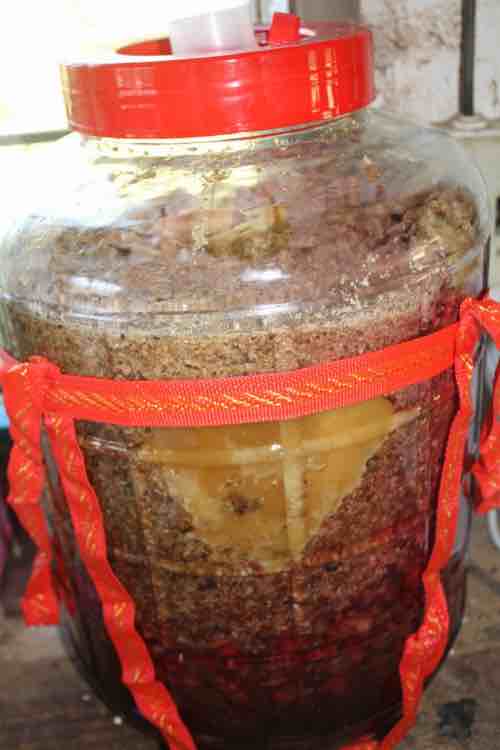
Brewing honey mead is the perfect way to make full use of that pollen; and the gleanings in the cappings.
Why does honey crystallise
There is another small advantage to having pollen in your honey. Why does honey crystallise
is a vexed question for some; it can set with an ugly, irregular texture. The pollen acts as seeds for this natural process,
giving a more uniform feel.
It takes time and energy to grind your own healthy flour for your baking and to produce your own natural comb; but it's fun, lucrative and starts with honey bee traps.
How many hobbies are there that more than pay their way?
The greatest benefit of course is improved health; natural honey has a low GI, unlike that which has been processed.
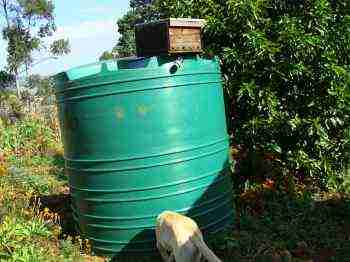
Honey bee traps
Honey bee traps should be made from a previously occupied hive; swarms like the smell of an old box. Alternatively daub them, in and out, with crushed black combs that have been boiled up.
Old hives for traps are perfect.
How you do get rid of honey bees?
Please don't poison them. Honey bees are seriously threatened; and pollinate one in four mouthfuls of our food. So do not call the exterminators.
Call in a beekeeper; amateur or professional.
After the 'keeper is finished very thoroughly block up every single hole or they will be back after a few months.
- Swarming bee traps with photos
- Raw honey
- Healthy flour and vitamin E
- Tomato prostate. Web: https://tinyurl.com/pxjd49k2
- Avocado benefits. Web: https://tinyurl.com/rh2xw75k
- SM McGladdery beekeeping and apiary equipment
When browsing use right click and "Open Link in New Tab" or you may get a bad gateway signal.
Did you find this page interesting? How about forwarding it to a friendly book or food junkie? Better still, a social media tick would help.
- Bernard Preston homepage
- Beekeeping
- Honey Bee Traps
Address:
56 Groenekloof Rd,
Hilton, KZN
South Africa
Website:
https://www.bernard-preston.com
